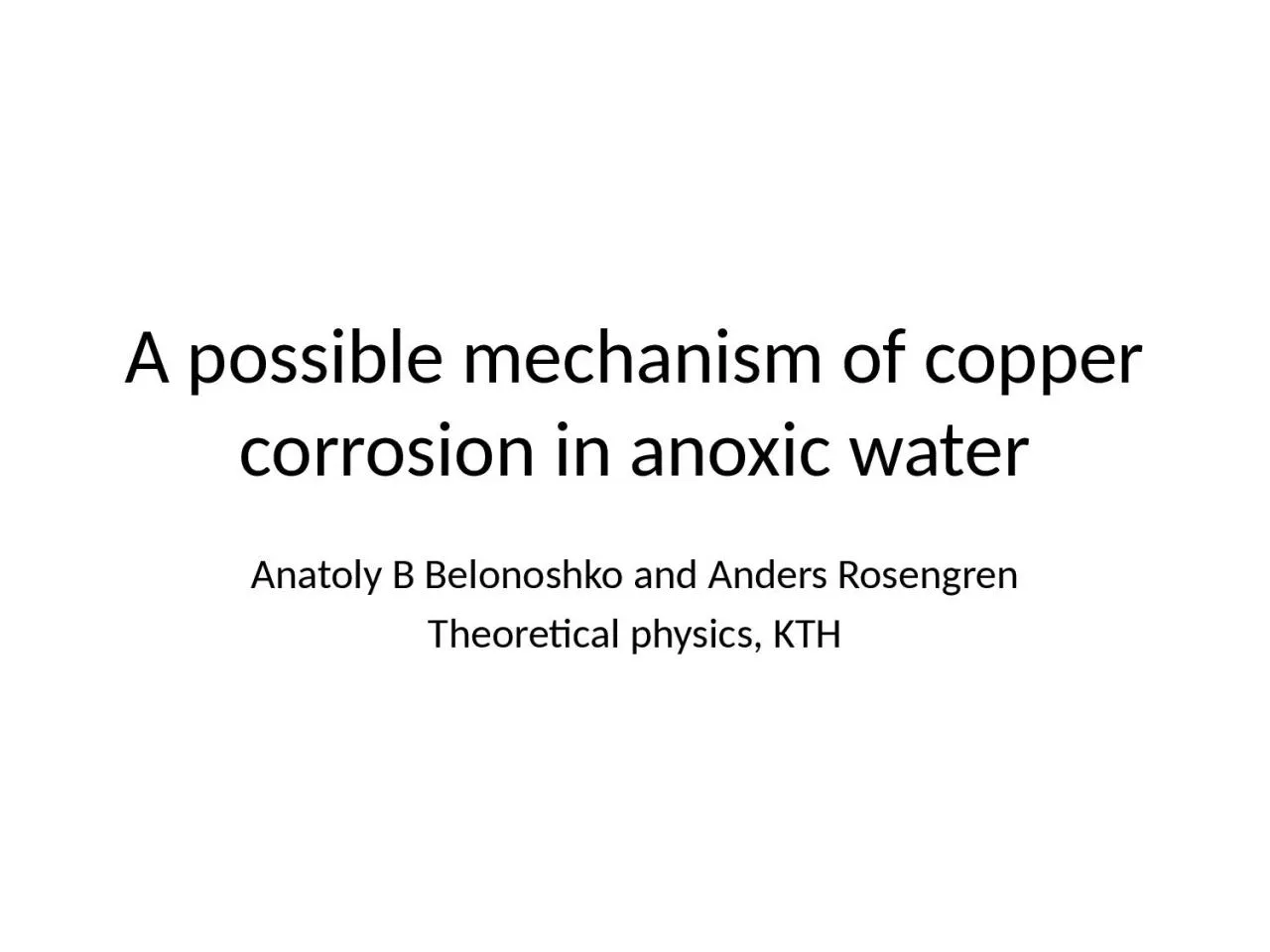

copper corrosion in anoxic water Anatoly B Belonoshko and Anders Rosengren Theoretical physics KTH Background Common belief Thermodynamic databases Electronic structure ID: 914494
Download Presentation The PPT/PDF document "A possible mechanism of" is the property of its rightful owner. Permission is granted to download and print the materials on this web site for personal, non-commercial use only, and to display it on your personal computer provided you do not modify the materials and that you retain all copyright notices contained in the materials. By downloading content from our website, you accept the terms of this agreement.
Slide1
A possible mechanism of copper corrosion in anoxic water
Anatoly B Belonoshko and Anders Rosengren
Theoretical
physics
, KTH
Slide2BackgroundCommon beliefThermodynamic databases
Electronic
structure
theory
Other
theoretical
studies,
other
surfaces
(Ren and
Meng
, Taylor,
Feibelman
)
Slide3Our calculationsWe study (100) surface
A supercell,
six
layers
of Cu in (001)
direction
and a
vacuum
layer
,
periodic
boundary
conditions
. The
size
10.905x10.905x21.810 Å
3
Surface
energy
1.388 J/m
2
,
exp
1.83 for (111)
Adsorption
energy
of a water
molecule
0.22 eV, same as
obtained
by
Tang
and Chen 2007
OH adsorption
energy
in excellent
agreement
with
Nørskov
et al 2007
Slide4Then inbetween slabs place OH and H separated
laterally
Calculate
energy
of
adsorbed
OH and H, i.e. of the
dissociated
water
molecule
. This
energy
is
lower
than
the
energy
of H
2
O
adsorbed
intact
.
Thus
we
find
dissociative
adsorption of water on the
surface
in
agreement
with Taylor .
Recently
confirmed
by
another
calculation
.
Slide5Computational cell
Slide6Continuous supply of free surface?A mechanism that continously provides
free
copper
surface
for water dissociation
We
have
earlier
suggested
one
mechanism
,
nanoparticles
, that
would
provide this
surface
Another
way
to
increase
this
surface
is to
take
grain
boundary
corrosion
into
account
.
If
grain
boundaries
facilitate
the removal of OH from the
surface
, the
available
surface
for OH adsorption is
essentially
the
surface
of all grains in the
sample
Slide7ClustersMagic number clusters N=13, 38, 55, 75, … unusually stable
Cu clusters
have
been
studied
by EAM for 2 to 150 atoms. First
principles
, up to 13 atoms
We
apply
first
principles
methods
from 2 to 55.
Put
them
in
cubic
box with
edge
15 Å.
Up-method
and
Down-method
Slide8The Cu cluster of 55 atoms
Slide9Slide10OH binding to cluster, cluster size + # hydroxylsBinding energy of OH to Cu(100)
surface
is -2.61 eV. This is
higher
than
the OH
binding
energy
to a
reasonably
large
cluster.
Question: Can this gain in binding energy compensate the cost in energy for transferring Cu atoms from the bulk to the cluster?
We
calculated
Cu
55
(OH)
42
.
Slide11The cluster of 55 Cu and 42 OH
Slide12ResultThe energy of Cu55 is -166.63 eV The energy
of Cu
55
(OH)
42
is -620.07 eV
The
energy
of
isolated
hydroxyls
is -378.78 eV
This gives OH
binding
energy
to cluster -3.21 eV
But
transfer of 55 Cu atoms from the bulk and 42 OH from the
surface
is
larger
by
9.89 eV
Conclusion
: Formation of
nanoparticulates
requires
considerable
energy
and is not relevant.
Slide13Diffusion in grain boundariesDiffusion of O in bulk Cu is negligibleRemoval of OH adsorbed on the Cu surface is
possible
via grain
boundaries
only
Grain
boundary
penetration or
intergranular
attack
At high
temperature
a grain
boundary
might
be
approximated
by a
liquid
structure
due
to
premelting
Slide14Modeling the grain boundaryHeat solid Cu to 4000 KAnneal the liquid to 300K, 1200 K and 2200K
At 300 K and 1200 K Cu is solid (no
self-diffusion
),
however
the radial distribution
function
remained
non-solid. Formation of
quasi-crystalline
planes is
seen
At 2200 K the
structure
is
liquid
and
quasi-crystalline
planes
vanish
Slide15Slide16Embedding OH in the grain boundaryTwo adjacent Cu atoms were
removed
from the center of the
computational
cell
One position filled with O the
other
with H
O and H
were
shifted
towards
each
other
to form the OH
bond
. Initial
configuration
.
Run
molecular
dynamics
D=2.25x10
-8
(2200 K), 1.04x10
-8
(1200 K) and 2.08x10
-9
(300 K) m
2
/s
Slide17Slide18Slide19Slide20Slide21Slide22DiscussionThe quantity of emitted hydrogen in the ongoing experiment
was
3x10
-6
g/cm
2
A
typical
grain
size
in the Cu
foil
was
10
-5
m.
Approximate
grains with
fcc
cubes
with
edge
10
-5
m.
Assume
all
surfaces
of grains
have
adsorbed
OH to
the same
extent
as the Cu
surface
Grain
boundary
thickness
2-10
atomic
distances
Slide23Order-of-magnitude estimateWe obtain 10-6
g/cm
2
.
The release of hydrogen
will
continue
Some
hydrogen
will
stay
in the
copper
Calculations
show that OH
dissociates
immediately
and O and H diffuse
independently
Strong
bond
forms
between
O and Cu, and H is
carried
away
Slide24Even more hydrogen is producedCopper oxide will be formed inside the crystal, probably as nanocrystalsHydrogen saturation leads to de-cohesion – as observed in experiments
Oxidation
will
lead
to a
lattice
expansion process,
which
might
give
rise
to cracks and
even
more
copper
surface
will
be
available
Slide25ConclusionsWe have investigated 2 possible
mechanisms
for OH removal from Cu
surface
Formation of Cu clusters with OH
adsorbed
Diffusion of OH in grain
boundaries
Possible
formation of
nanocrystals
of
copper
oxide
. Cracks.